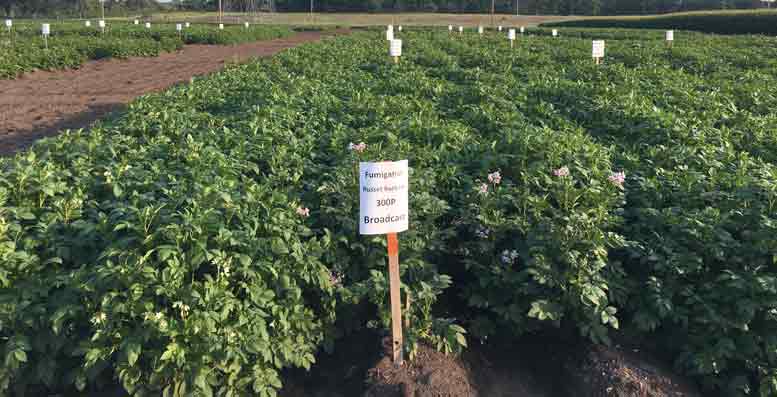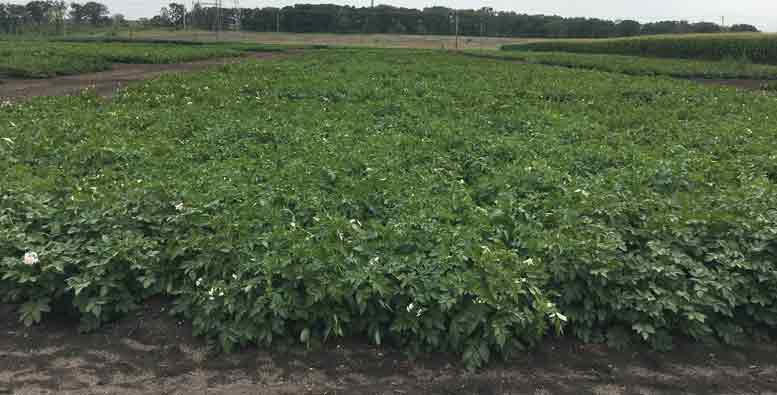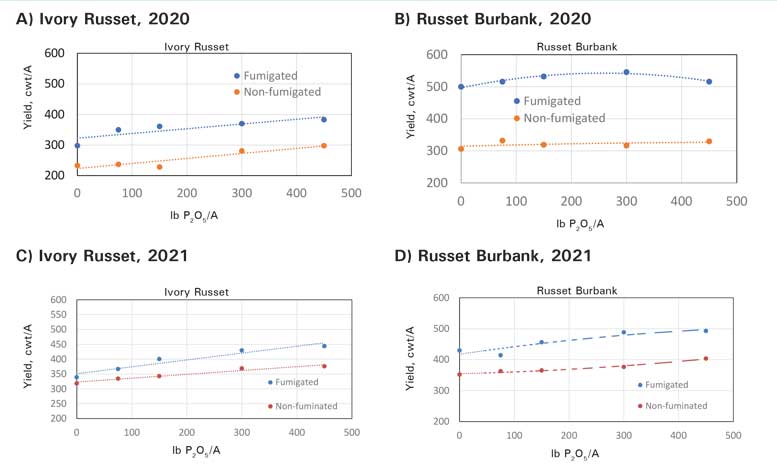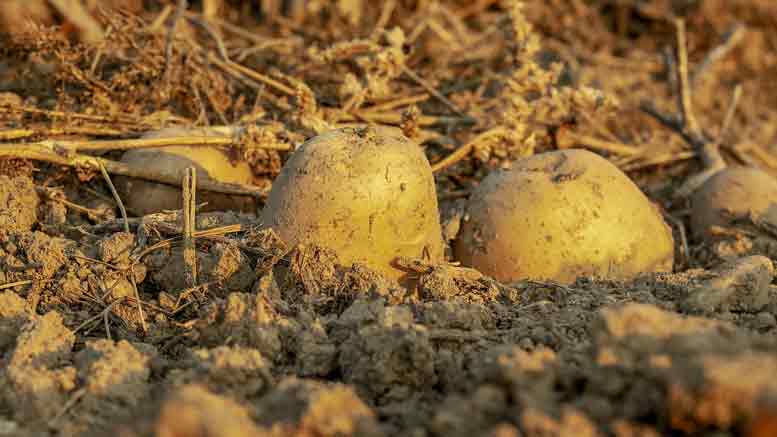|
Click to listen to this article
|
By Carl Rosen, Professor, University of Minnesota
Phosphorus (P) is a macronutrient essential for all forms of life. A deficiency of P in potatoes is associated with delayed vegetative growth, poor tuber set and bulking, and reduced yields. Excess P seldom affects plant growth, but it can increase eutrophication if it moves offsite into surface water. Phosphorus management is, therefore, an important consideration from both production and environmental standpoints.
Phosphorus fertilizer recommendations for potatoes are often based on soil test P and yield goal, but numerous studies have shown that economic responses can sometimes occur even on high P testing soils. For this reason, some P fertilizer is usually recommended for potatoes even when soil test P is high. However, a P response is not always guaranteed even on lower P testing soils.


Phosphorus in soil exists in both inorganic and organic forms. It is considered a very immobile soil nutrient with availability of inorganic forms primarily controlled by soil pH. In acid soils, P binds tightly to soil particles by forming insoluble iron and aluminum compounds, and in alkaline soils, it forms insoluble calcium compounds. The optimal soil pH for P availability is generally between 6 and 7. Placement of P fertilizer in a band near the root system is one way of increasing P availability.
The reasons why potatoes often respond to phosphorus even under high soil P conditions are not entirely known but could be related to several factors. For example, potatoes naturally have a limited root system and the practice of hilling limits that root system even further. Because P is immobile in soil, plant roots depend on an increased root surface area to increase the probability of intercepting soil P in areas that have not yet been depleted. As plant roots take up P, the amount available for further uptake decreases; therefore, growing into areas of higher soil P is an important adaptation to increase P supply to the plant.
Soil pH may also be a factor that limits P uptake. As previously mentioned, fixation by iron and aluminum in acid soils and calcium in alkaline soils reduces P availability. For some varieties, soils are maintained at a pH below 5.5 to control common scab. While this practice can improve tuber quality, it may also result in lower P availability.
Another reason for variable P response may be due to soil-borne diseases such as Verticillium and pathogenic nematodes, which can further limit root growth. To control soil-borne diseases, fumigation is used, but this practice is not specific to disease organisms and may also reduce beneficial microbes such as mycorrhizae. Mycorrhizae are naturally occurring symbiotic fungi that form a symbiotic relationship with plant roots to increase root surface area and, therefore, improve phosphorus uptake.
Finally, there could be distinct varietal differences in P uptake due to differences in root structure and surface area. Some varieties may be more efficient in P acquisition and uptake than others due to root adaptations to solubilize fixed P or breakdown organic P.

Objectives
To explore some of these factors in more detail, a two-year experiment was conducted at the Sand Plain Research Farm in Becker, Minnesota, with an overall goal of improving predictability of potato response to P fertilizer. Specific objectives were to 1) compare P response of two potato varieties in fumigated and non-fumigated soils, 2) determine the effect of mycorrhizal inoculation on P response, and 3) evaluate broadcast vs. banding of P fertilizer on tuber yields.
Methods
The soil at the experimental sites had a pH that ranged from 6.4 to 6.9 and a Bray P soil test that ranged from 95 to 126 ppm. The pH was in the range for optimum P availability, and soil test P was in the very high range, indicating the probability of P response to applied fertilizer for most crops would be low. Treatments for this study included, with and without fumigation, two varieties, Russet Burbank and Ivory Russet, and nine P treatments replicated four times for a total of 144 plots. The nine P treatments were: 0, 75 150, 300 and 450 lbs P2O5/acre as triple super phosphate broadcast applied and incorporated in the spring before planting, mycorrhizae inoculation without P fertilizer and with mycorrhizae with 150 lbs P2O5 broadcast applied, banded P fertilizer at 75 and 150 lb P2O5/acre. Fumigated plots received 40 gallons of Vapam the first year and 50 gallons the second year. MycoGold was used as the mycorrhizae inoculant and applied at the labeled rate in furrow at planting. The experiment was set up as a split-split plot treatment arrangement with fumigation as the main plot, variety as the subplot and P treatment as the sub-sub plot.
Results
P rate and fumigation response: Total yield increased with increasing P rate in both years of the study for Ivory Russet under both fumigated and non-fumigated conditions (Fig. 1a, 1b). In contrast, the P response for Russet Burbank in the first year of the study was not significant (Fig 1c). However, in the second year of the study, Russet Burbank yields increased with an increasing P rate in both fumigated and non-fumigated conditions (Fig 1d). At equivalent P rates, yields for both varieties were higher under fumigated conditions than non-fumigated conditions.
Mycorrhizae inoculation: Over the two years of the study, mycorrhizal inoculation had no effect on yield of either variety when applied at planting at 0 and 150 lb P2O5/acre under non-fumigated or fumigated conditions (Table 1). These results suggest the P response in these soils is not related to lack of mycorrhizal associations.

Banding vs. broadcast-applied P: Mixed effects were found for P placement over the two years. In the first year, banding at equivalent rates to broadcast had no effect on yields for Russet Burbank in either fumigated or non-fumigated conditions. There was an unexpected decrease in Ivory Russet yields when banding was used under fumigated conditions and no effect of placement under non-fumigated conditions. In the second year of the study, results were more consistent, with banded P applications tending to increase yields of both varieties when compared to broadcast applications at equivalent P rates, although the effect was statistically significant at only the 75 lb P2O5/acre rate under fumigation (Table 2).
Phosphorus fertilizer economics: Phosphorus fertilizer prices have more than doubled over the past two years with a current cost of $1.02/lb P2O5. The yield increase of 0.127 cwt would be required to pay for each extra pound of P2O5 applied assuming a value of $8/cwt. Based on a cost analysis for the second year of the study, adding P fertilizer at current prices would only have been cost effective when potatoes were grown under fumigated conditions. This suggests that root growth under non-fumigated conditions was not sufficient to take advantage of the extra P fertilizer applied when P fertilizer costs are high and would result in a loss. If the cost of P fertilizer decreased to pre-2020 levels, P fertilizer addition would be cost effective. These results suggest that under fumigated conditions, it is important to optimize other inputs to realize the full effect of fumigation.
Summary, Conclusions
The reason why potatoes sometimes respond to P fertilizer in high P testing soils continues to be puzzling. However, based on this research, it is unlikely due to lack of mycorrhizal associations. Ivory Russet was more responsive to P the first year of the study than Russet Burbank, but both varieties responded to P fertilizer the second year. Phosphorus response was observed under both fumigated and non-fumigated conditions, but there seemed to be a greater response to P with fumigation. Banding was effective in one of the two years and may reduce the need for higher P application rates. While potatoes can respond to P fertilizer in high P testing soils, yield increases may not be sufficient to offset the current high cost of P fertilizer, especially if soil-borne diseases are prevalent.
Author’s note: This research was supported by the Minnesota Area II Potato Grower’s Research and Promotion Council and the Minnesota Agricultural Fertilizer Research and Education Council.

